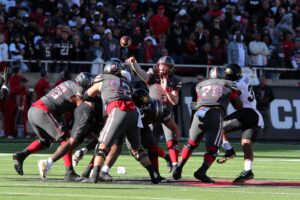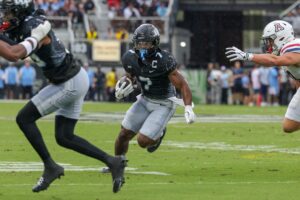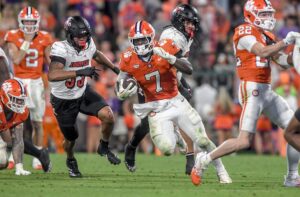Previewing the Backyard Brawl
Soon enough, we will stop speculating on what could be and start talking about what actually happened. That is right, fans. The college football season is upon us. This Thursday, September 1, the West Virginia Mountaineers and Pitt Panthers will renew a rivalry that spans 104 prior meetings. The opening kick will happen at 7:00 at Heinz (err, Acrisure) Field. We offer, then, our final pre-season thoughts on the Mountaineers while previewing the Backyard Brawl.
Rosters by the Numbers
This season, we add a feature to our previews that compare the average 247Sports composite ranking for each team’s starters for each position group. This is more difficult for game one because the teams’ depth charts are still in flux. That said, for the Mountaineers we use our own predicted depth chart, and, for Pitt, we rely on projected depth charts from various Pitt writers.
The Trenches
First, we compare the offensive lines. The numbers here are most misleading, but we just offer what we see. The projected WVU starters (there are still some doubts as to who starts at right tackle and whether we see a position change to get the best five on the line) average a composite rating of 0.8962. The Pitt starts average a composite rating of 0.8646. Now, nobody will say that West Virginia’s offensive line has performed better than Pitt’s, even though both schools return the same starters as last season. Pitt’s starting line is going on its third season of continuity filled with sixth-year players. WVU has less experience and is on season two of continuity. These things matter; as a result, we give Pitt’s offensive line the edge over West Virginia’s (but not by as wide a margin as fans perceive).
Second, we compare the defensive lines. Pitt’s starters carry an average composite rating of 0.8531, while West Virginia’s starters average 0.8787. Both teams return plenty of experience, and they are both among a very small percentage of schools that return most of the defensive line production from a year ago. The defensive lines are a push based on performance, with perhaps the slightest advantage to Pitt.
The Skill Positions
First, we start at wideout. The Mountaineer receivers carry an average composite rating of 0.8785, while Pitt’s receivers tout an average rating of 0.8289. West Virginia holds the advantage on experience and production as well, as Pitt loses five of its top seven receiving targets from last season. We give this to the Mountaineers.
Next, we look at running back. Pitt’s presumptive starter has a composite rating of 0.8845, while West Virginia’s Tony Mathis has a composite rating of 0.8572. Pitt has the advantage of experience here as well, so we give this battle to the Panthers.
Now, we look at the tight end. Mike O’Laughlin and Brian Polendey both carry higher composite ratings into the game than Pitt’s Gavin Bartholomew. On West Virginia’s side, both are fifth-year players, too. The teams have used their tight ends differently, so an even comparison by statistics does not tell the tale. We give West Virginia the slight advantage here.
Finally, we look at the quarterback. JT Daniels was an undisputed five-star out of high school, while Kedon Slovis carried a mid-three-star rating. Slovis has stayed healthy longer than Daniels, so Slovis has greater total raw numbers. That said, Slovis has also regressed each year since his breakout freshman campaign (taking over for an injured Daniels). Provided both players stay on the field, we give this advantage to West Virginia.
The Linebackers and Secondary
We have heard Pitt fans tout their linebackers regularly. SirVocea Dennis certainly had some productive seasons, particularly last year when he racked up 82 tackles (10 for loss). His mates, however, played backup roles last season, and Pitt lost three linebackers over the offseason. Collectively, their group fields an 0.8372 composite average. The Mountaineers use only two true linebackers, but we count the bandit position here. They return some experience there and with Lance Dixon, and they add potential star Lee Kpogba to the middle. Collectively, they average a composite rating of 0.8815. Both units have some inexperience to deal with, but we give the advantage to West Virginia.
Because the teams run their secondaries a little differently (the Mountaineers’ base formations feature five defensive backs), we are grouping the cornerbacks and safeties together. West Virginia will rely heavily on FCS transfers in their secondary, so three players do not carry composite ratings into the season. The two who do average an 0.8720 rating. Pitt builds it’s secondary the traditional way, and they average an 0.8552 rating. That said, Pitt’s biggest weakness last season was it’s secondary. West Virginia found strength in its secondary as the season wore on, especially with the revelation of Charles Woods. That said, while we continue to believe the Mountaineers’ secondary will be a strong spot, we have to consider this position battle a push.
But Do the Numbers Matter?
As we wrote this weekend, according to the players who have lined up in the game, when either previewing the Backyard Brawl (or playing it), we can throw records, predictions, ratings, rankings, and favorites out the window. We analyzed how much things like composite ratings matter to the results of football games. We concluded that composite ratings for teams accurately predict over 70% of games played by Power Five teams. Both Pitt and West Virginia eclipsed their expected win totals based on the composite ratings last year. Pitt finished with 11 wins versus the expected nine (they played the 61st-best strength of schedule). West Virginia finished with six wins versus the expected four (they played the 23rd-best strength of schedule. Thus, even overlooking the fierce nature of this rivalry that has produced plenty of unexpected results, both Pitt and West Virginia have outpaced data-based expectations in recent seasons.
Both teams have some great things going for them. Pitt won the ACC title. They return the majority of their starters on defense and all of their starters on their offensive line. West Virginia returns plenty of its receiver production and two guys who are entering their fifth years in the program. For the first time in a while, they return all five starting offensive linemen (even if one of those positions is still in question through preseason competition). They also return most of their defensive line talent.
Both teams face some questions. What will the loss of their Heisman-candidate quarterback, Biletnikoff-finalist wideout, and offensive coordinator mean for Pitt? Do the addition of Daniels and new offensive coordinator Graham Harrell solve the Mountaineers’ lackluster offense over the past few years?
These questions will be answered soon enough. The countdown finally measures in days (maybe even hours) instead of months and weeks. And as Wolfley and Jozwiak told us, no matter how we frame it, this will be a “street fight” between teams who hate each other. In Previewing the Backyard Brawl, forced to make a call, we think the Mountaineers come out firing and surprise virtually everyone (as they have done plenty of times over the years). That said, we will not be surprised by either outcome.






